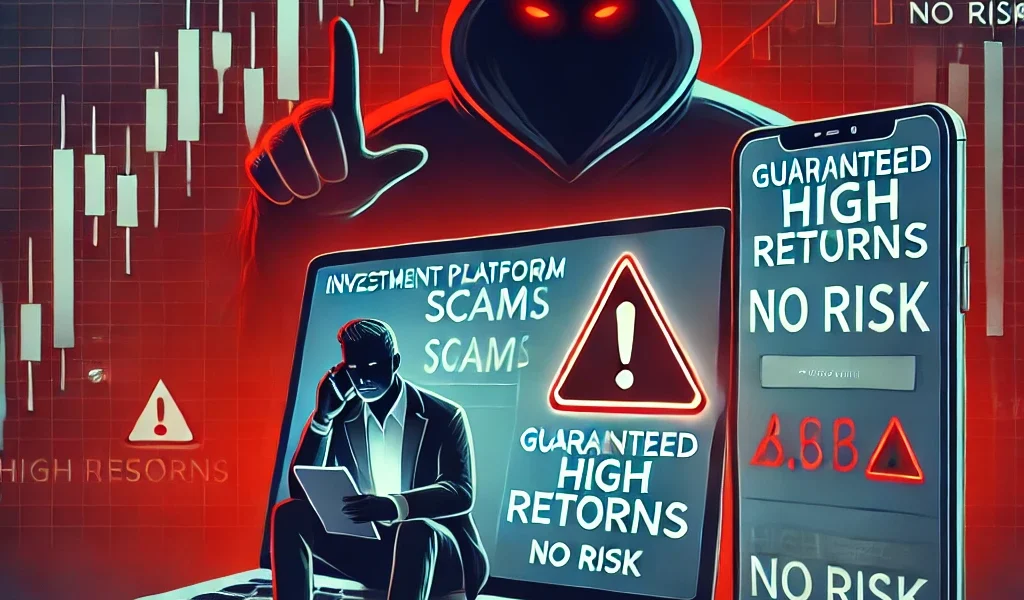Introduction
With the rise of online investment platforms, financial markets have become more accessible than ever. However, this convenience has also opened the door to fraudulent schemes that prey on unsuspecting investors. Scammers create fake investment platforms that promise high returns, only to disappear with investors’ money.
This guide will help you identify red flags of investment platform scams, protect your hard-earned money, and choose a legitimate platform for secure investing.
1. Common Types of Investment Platform Scams
Understanding the different types of scams can help you recognize them before falling victim. Here are the most common types:
1.1. Ponzi and Pyramid Schemes
These schemes promise high returns with little or no risk. Early investors are paid with the money from new investors, but once recruitment slows down, the scam collapses, leaving most investors with huge losses.
1.2. Fake Trading Platforms
Scammers create professional-looking websites that mimic legitimate investment platforms. They lure investors by offering free sign-ups, bonuses, and fake trading tools. Once investors deposit funds, the site either refuses withdrawals or disappears overnight.
1.3. Pump-and-Dump Schemes
Fraudsters artificially inflate the price of a stock or cryptocurrency by spreading misleading information. Once prices soar, they sell off their holdings, leaving other investors with worthless assets.
1.4. Phishing Scams
Hackers send emails or messages pretending to be from a trusted investment platform. They trick users into revealing personal information, login credentials, or credit card details.
1.5. Unregistered Brokers
Some investment platforms operate without regulatory approval. These brokers might offer attractive terms but lack investor protection, meaning your money is not secure.
2. Warning Signs of a Fraudulent Investment Platform
To protect yourself from scams, watch out for these red flags:
2.1. Unrealistic Promises
If an investment platform guarantees high returns with no risk, it is likely a scam. Legitimate investments always carry some level of risk.
2.2. Lack of Regulation and Licensing
Verify if the platform is registered with financial authorities like the SEC (USA), FCA (UK), or SEBI (India). Fraudulent platforms often operate without proper licensing.
2.3. No Clear Contact Information
Scam websites may have fake or no contact details. A legitimate investment platform will have a physical address, phone number, and customer support.
2.4. Pressure to Invest Quickly
Fraudsters often use urgency tactics, such as “limited time offers” or “only a few spots left,” to pressure victims into investing without proper research.
2.5. Poor Website Quality and Security Issues
Check the website’s URL for security (https://), verify its domain age, and look for grammatical errors in content. A poorly designed website can be a sign of fraud.
2.6. Complicated or Unclear Withdrawal Policies
Scammers make it easy to deposit funds but difficult to withdraw them. Be wary of platforms with hidden fees, withdrawal delays, or unclear policies.
2.7. Overwhelmingly Positive Reviews on Unverified Sites
Fake platforms often flood the internet with positive reviews from fake users. Check independent review sites and investor forums for unbiased opinions.
3. How to Verify if an Investment Platform is Legitimate
Before investing, take the following steps to verify the authenticity of a platform:
3.1. Check Regulatory Registrations
Look up the platform’s registration with official financial regulatory authorities. Most regulators have online databases where you can check if a company is licensed.
3.2. Research the Company’s Background
Use sources like LinkedIn, news articles, and investor forums to learn about the company’s founders, management team, and history.
3.3. Read the Terms and Conditions
Carefully review the platform’s policies regarding withdrawals, fees, and account security. Fraudulent platforms often have vague or misleading terms.
3.4. Test the Customer Support
Try reaching out to the platform’s customer service before depositing money. Legitimate companies will have responsive support teams.
3.5. Start with a Small Investment
If you are unsure about a platform, start with a small amount and attempt a withdrawal before making a larger investment.
3.6. Use a Secure Payment Method
Avoid platforms that require only cryptocurrency or wire transfers, as these transactions are harder to trace and recover in case of fraud.
4. What to Do If You Fall Victim to an Investment Scam
If you suspect you’ve been scammed, act quickly:
4.1. Stop Further Transactions
Do not deposit more money or share additional personal information.
4.2. Contact Your Bank or Payment Provider
Report the scam and request a chargeback or fraud investigation if you made payments through a credit card or bank transfer.
4.3. Report to Financial Authorities
File a complaint with relevant regulatory bodies such as the SEC, FCA, or local consumer protection agencies.
4.4. Warn Others
Post your experience on investment forums and social media to prevent others from falling victim.
4.5. Consider Legal Action
In some cases, hiring a lawyer or working with financial fraud recovery services may help recover lost funds.
5. Final Thoughts: Stay Vigilant and Invest Safely
Investment scams continue to evolve, but by staying informed and conducting due diligence, you can protect yourself from fraudulent platforms. Always research before investing, trust only regulated platforms, and never rush into financial decisions.
Quick Checklist to Avoid Investment Scams:
✅ Verify platform registration with financial authorities ✅ Check for transparent contact details and customer support ✅ Avoid platforms promising guaranteed high returns ✅ Research independent reviews and investor experiences ✅ Start with a small investment and test withdrawals ✅ Use secure and traceable payment methods




